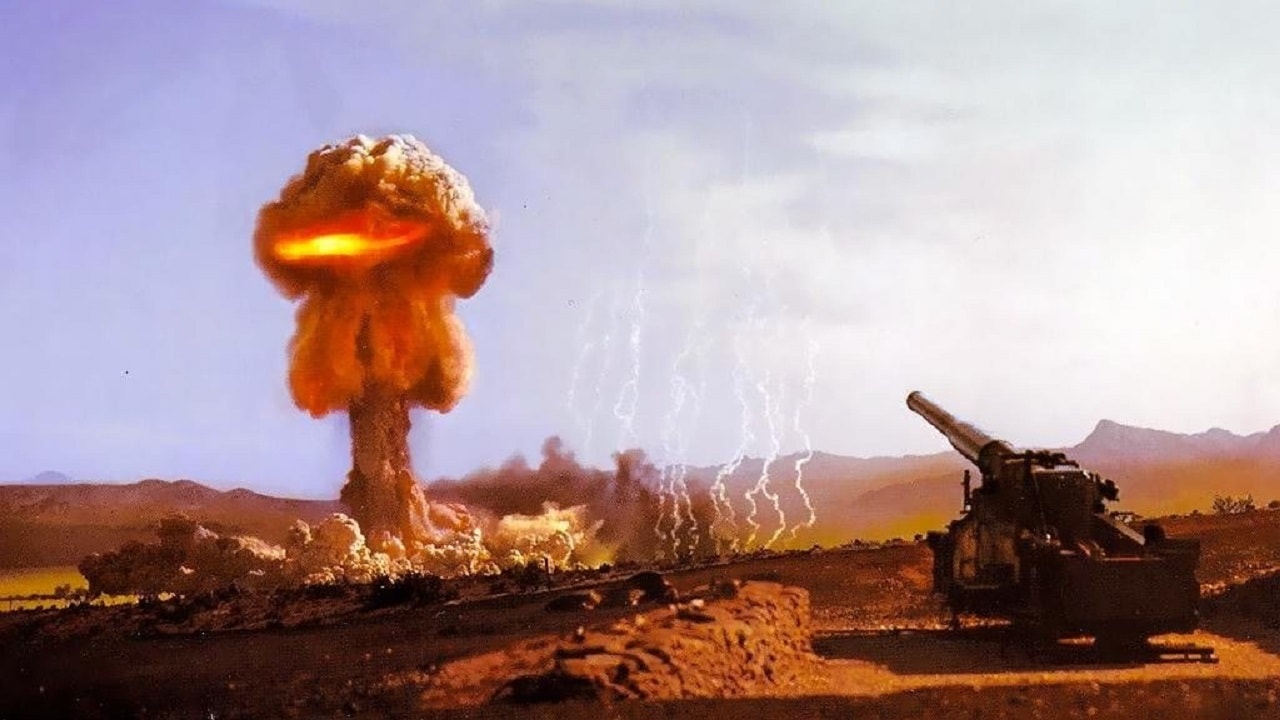In the first half of the twentieth century, the United States was the only nation to possess atomic weapons. By 1949, however, the American monopoly on atomic weaponry changed when the former USSR exploded an atomic bomb.
Igniting the arms race that would consume the Soviet Union and America for decades to come, atomic weaponry would soon become a staple in military arsenals in the Cold War-era. Perhaps the most unique weapon that emerged during this time period was a nuclear cannon dubbed “Atomic Annie.”
Officially designated the M65 280mm Motorized Heavy Gun, the cannon was only fired once.
Notably, the cannon could fire a nuclear round packed with as much explosive power as the bomb that devastated Hiroshima. While Atomic Annie was ultimately rendered obsolete due to the creation of other mobile rocket systems, the atomic cannon remains a favorite among military buffs.
A brief overview of Atomic Annie
After the USSR exploded an atomic bomb for the first time in the late 1940’s, U.S. engineers went to work to develop a nuclear-capable artillery piece. Then-president Dwight Eisenhower envisioned a peaceful strategic impetus for the development of an atomic cannon. In an effort to reduce defense budgets, the former president thought that nuclear weapons could reduce the cost and reliance on soldiers and conventional weapons alike.
As detailed by the National Park Service, Eisenhower “feared the effects of a broad Cold War fight on America’s economy and society. Increased military spending could warp the marketplace, while efforts to combat Communism at home, if not carefully regulated, might ultimately undermine American civil liberties.”
The original designs of the weapon were largely derived from the 240mm howitzer shell and German K5 railroad gun. The nickname Atomic Annie actually stems from a pair of German K5 guns that were used against U.S. landings in Italy. The resulting prototype resembled a large fire engine with two horsepower tractors positioned at each end.
The two-tractor system was capable of independent steering while the drivers could communicate with a newly developed phone system. Weighing around 85 tons, the cannon necessitated two transported trucks to move. By 1954, the U.S. military used the rail system to relocate the M65 to a test site in Nevada, where soldiers used one of the two cannons to fire a nuclear artillery shell in a live-fire test.
The M65 atomic cannon was only fired once
During the atomic cannon test called “Grable,” the nearly $1,000,000 (more than $8 million today) cannon performed as expected. Grable was the 10th in the Operation Upshot-Knothole nuclear weapon test series, which all took place at the same Nevada test site.
Following the successful test launch, viewed by the then-Chairman-delegate of the Joint Chiefs of Staff Admiral Arthur W. Radford and then-U.S. Secretary of Defense Charles Wilson, at least 200 cannons were manufactured at the Watertown and Watervliet Arsenals. While the cannons were deployed overseas over the next decade, the M65 was ultimately declared obsolete and formally retired in 1963.
What happened to the backup cannon?
A second M65 cannon was present during the “Grable” tests in Nevada as a backup. Dubbed “Sad Sack,” the atomic weapon was never actually fired.
The initial plan was to send Atomic Annie back to Fort Sill and deploy Sad Sack overseas. However, the two cannons were accidently switched on their transit routes leaving Nevada.
As explained in Real Clear Defense, “While traveling down a treacherous mountain pass in Germany, one of Annie’s tractors slid off the road. The vehicles that moved the heavy cannon crashed, and two of her crew died. Despite the setback, Atomic Annie did make it home to Fort Sill, where she sits to this day. Curious visitors can find her at the base’s artillery park—part of the U.S. Army’s Field Artillery Museum.”
The few remaining atomic cannons that were made are displaced in museums across the country. The Sad Sack was sold to the Smithsonian, where the weapon resides today and the original Atomic Annie test cannon actually remains at Fort Sill.
Maya Carlin, a Senior Editor for 19FortyFive, is an analyst with the Center for Security Policy and a former Anna Sobol Levy Fellow at IDC Herzliya in Israel. She has by-lines in many publications, including The National Interest, Jerusalem Post, and Times of Israel. You can follow her on Twitter: @MayaCarlin.
From 19FortyFive
Total Massacre’: Ukraine Footage Shows Russian Cruise Missile Shipment Attacked
Video – Ukraine Has Massive New NATO ‘Cannon’ Ready To Fight Russia
‘Americans Will Pay The Price’: One Democrat Is Angry At Joe Biden

